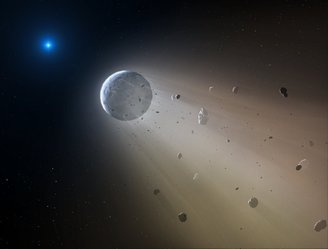We often look at the stars to see the past because their light takes time to reach us. But in a rare astronomical observation using gravitational microlensing, a team of astronomers took a look into the future: An Earth-like planet orbiting a white dwarf star 4,000 light-years from the Milky Way.
Although the exoplanet is not exactly the size of Earth (1.9 times our mass), it provides a preview of what will happen in the future if the Sun turns into a white dwarf after its red giant phase. This Earth-sized planet, which may have existed in an orbit like ours, offers “hope” for Earth’s possible survival.
In a paper recently published in the journal Nature Astronomy, the team led by astronomer Keming Zhang from the University of California (UC) explains how this happens. used the phenomenon known as microlensing, where the gravity of a large object “magnifies” light from a more distant objectTo observe the white dwarf orbiting the Earth-mass planet, as well as its companion brown dwarf.
Earth-like planet reveals our future
The distant system detected by UC astronomers through observations with the 10-meter Keck telescope in Hawaii is like a projection of what might happen in the Sun-Earth system in the future. five billion years from now when our star reaches the final stage of its evolution.
Once its core hydrogen fuel runs out, the Sun will begin to swell, turning into a red giant larger than Earth’s current orbit, potentially swallowing us, Mercury, and Venus in the process. However, as it expands, mass loss may cause some planets to migrate into more distant orbits.
Current theories suggest that terrestrial planets that form within one to three astronomical units (AU) of their stars may avoid being engulfed during the red giant phases of their host stars. This will give Earth the means to surviveAs the red giant’s outer layers are ejected, until only a dense white dwarf the size of Earth remains.
How did the Earth-like planet survive?

Although only a few gas giant planets have been observed around white dwarfs to date, the planetary system observed by the UC team “provides an example of a surviving planet despite being well outside the faint white dwarf’s habitable zone and unlikely to host life,” they say in a press release.
It is irrelevant to know whether the planet has had habitable conditions during its existence, because as the Sun gradually becomes brighter, “Planet Earth will only become habitable for another billion years, as the planet’s oceans evaporate due to a long period of uncontrolled greenhouse effect.” “Before the risk of being swallowed by the red giant,” says author Keming Zhang in one of his publications.
not yet Consensus on whether Earth can avoid being swallowed by the Sun The UC doctoral student says it will be in the red giant stage six billion years from now. In the case of the observed exoplanet, Zhang says, “The simplest explanation is that the planet has survived the red giant phase of its host star.”
Use gravitational microlensing to see more

According to Zhang, the system was only observed due to a bit of luck due to a phenomenon known as microlensing, which takes advantage of a property of gravity.
The white dwarf system is about 4,200 light-years away, but about 26,100 light-years away and in the same line of sight from Earth. alignment of a very large and bright star for a few minutes.
As light from the more distant star passed through the white dwarf, its path was bent by its gravitational field, resulting in this impressive magnification effect.
Did you like the content? Stay up to date with more studies like this on TecMundo and get the opportunity to find out whether every star is the Sun or not. See you later!
Source: Tec Mundo
I’m Blaine Morgan, an experienced journalist and writer with over 8 years of experience in the tech industry. My expertise lies in writing about technology news and trends, covering everything from cutting-edge gadgets to emerging software developments. I’ve written for several leading publications including Gadget Onus where I am an author.












